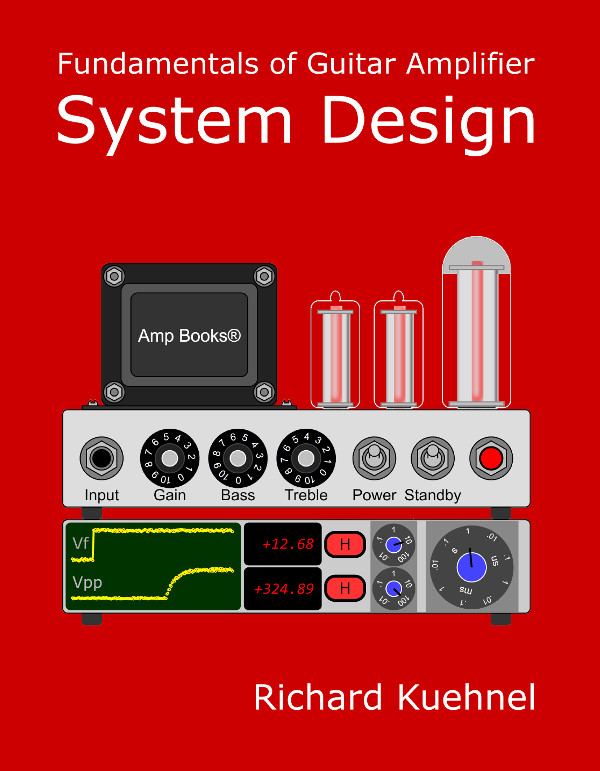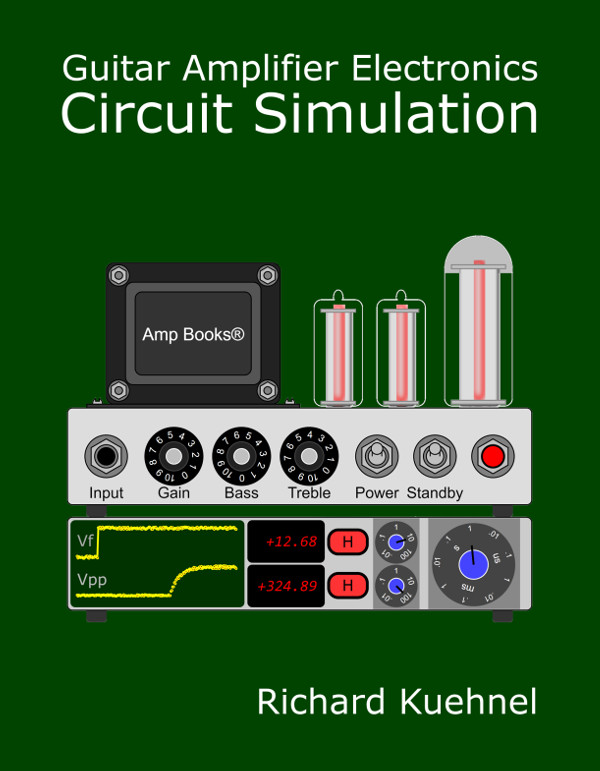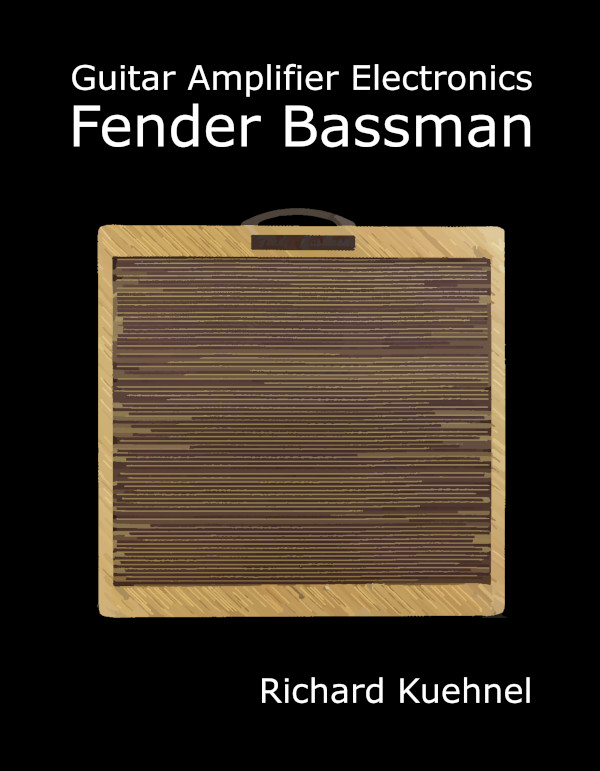Circuit Analysis of the Gretsch Chet Atkins
The Gretsch Chet Atkins amplifier has a unique architecture: an active 12AX7 mixer driven by independent channels, each in turn having separate bass and treble channels that drive a passive mixer. This article focuses on these aspects of the design. It also derives a formula for the gain of the active mixer.
Preamp
Unlike that vast majority of guitar amplifiers, the Gretsch Chet Atkins uses the two triodes of a 12AX7 to drive bass and treble controls independently. Each triode forms a traditional common-cathode voltage amplifier. The treble channel preamp is as shown here.

The coupling capacitor driving the bass control is large enough to act as a short circuit for all audio frequencies. For the treble driver, it is only 0.001μF, which creates significant bass attenuation. The cathode resistor for the treble driver is 1.5kΩ and is bypassed by a 35μF capacitor. This effectively shorts the cathode to ground for all audio frequencies and creates 38dB gain. The cathode resistor in the bass driver is larger, 2.2kΩ, and unbypassed. According to the Preamp Gain and Output Impedance calculator, this reduces the unloaded gain to 34dB.

The treble driver's output impedance1 is about 51kΩ. The calculator shows that the bass driver has an output impedance of 139kΩ. In many circumstances a high output impedance is a disadvantage, because the stage is more likely to be loaded down by the current it is forced to supply to drive the next stage. In this case, however, the output impedance is a desirable artifact. The design, in fact, places a 150kΩ resistor in series with the output impedance driving the bass channel, as shown below.

|
Guitar Amplifier Electronics: Fender Deluxe - from TV front to narrow panel to brownface to blackface Reverb |
Bass Control
The bass control circuit consists of a cascade of two RC low-pass filters followed by a volume control.

The potentiometer and resistor below it effectively form a 600kΩ control with a lower limit of 100kΩ. Here is the response based on a SPICE Simulation2 with the bass control at minimum, 50-percent resistance, and maximum.

The driving circuit output impedance is assumed to be 139kΩ. Clearly there is severe treble cut, which ensures that the bass control only affects bass frequencies. Moreover, if we extend the plot down to frequencies well below audio, we see that parts values are chosen to put bass frequencies above the -5dB, -10dB, and -20dB low-frequency plateaus created when the capacitors act as open circuits.

By the time the signal frequency increases to 82Hz, the lowest note on a guitar with standard tuning, response is about halfway to the -40dB per decade region created by the cascade of two RC lowpass filters.

|
Guitar Amplifier Electronics: Basic Theory - master the basics of preamp, power amp, and power supply design. |
Treble Control
The treble control consists of a high-pass T network followed by a volume control.

Here is the response assuming a driving circuit output impedance of 51kΩ.

This time the control region extends into the treble plateau.

|
Fundamentals of Guitar Amplifier System Design - design your amp using a structured, professional methodology. |
The Passive Mixer
100k resistors are used to mix the treble and bass signals together.

In contrast to the isolation of the bass and treble driving stages, the passive mixer introduces some interactivity to the controls. Turning down the bass control affects treble response via the mixing resistors and vice versa. Even with isolated drivers, the Chet Atkins controls have substantial interactivity, a characteristic common to many classic amplifiers. The 100kΩ limiting resistors mitigate the effect somewhat by limiting the load each stage presents to the other.

|
Guitar Amplifier Electronics: Circuit Simulation - know your design works by measuring performance at every point in the amplifier. |
Active Mixer
The Chet Atkins also contains an active mixer that is rarely seen in a guitar amp. The preamp has two channels, each with its own bass and treble controls and passive mixer. The channels are combined in a 12AX7-based mixing circuit.

The output is taken from where the plates connect to the 100kΩ plate load resistor. Since the resistors carry the plate current of two triodes, the DC operating point is the same as for a single triode with a 200kΩ plate load resistor and 3kΩ cathode resistor.
AC voltage gain for each channel is less than for a single triode amplifier. Imagine a rising voltage on the left input (channel 1) and no signal on the right. The increasing grid-to-cathode voltage causes an increase in plate current through the left triode, which creates more current through the cathode resistor. This raises the voltage across the resistor, causing the cathode voltage to rise and counteract the rising grid-to-cathode voltage induced by the input signal. This represents classic negative feedback. Moreover, there is common cathode coupling: a rise in cathode voltage for the left triode creates a similar rise in cathode voltage for the right triode. The net result is that the rising input signal causes the total current through the 100kΩ plate load resistor to increase while at the same time negative feedback in both triodes causes the total current to decrease.
The Radiotron Designer's Handbook3 calls this a "common plate load mixer." We posted a calculator that computes voltage gain and output impedance based on the tube and the values for the plate load and cathode resistors.
References
1Richard Kuehnel, Guitar Amplifier Electronics: Basic Theory, (Seattle: Amp Books, 2018), pp. 68-69.
2Richard Kuehnel, Guitar Amplifier Electronics: Circuit Simulation, (Seattle: Amp Books, 2019).
3F. Langford-Smith, Ed., Radiotron Designer's Handbook, 4nd Ed., (Harrison: RCA, 1953), p. 800.
3Richard Kuehnel, Circuit Analysis of a Legendary Tube Amplifier: The Fender Bassman 5F6-A, 3rd ed., (Seattle: Amp Books, 2009).

|
From system design concepts to individual stage operation, an all-new examination of Bassman electronics. |


